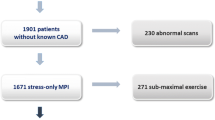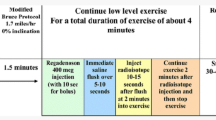Abstract
Purpose
Our study assesses the routine reporting of exercise ischemia using very low-dose exercise-first myocardial perfusion SPECT in a large number of patients and under real-life conditions, by evaluating correlations with the subsequent routine reporting of coronary stenosis by angiography and with factors that predict ischemia.
Methods
Data from 13,126 routine exercise MPI reports, from 11,952 patients (31% women), using very low doses of sestamibi and a high-sensitivity cardiac CZT camera, were extracted to assess the reporting of significant MPI-ischemia (> 1 left ventricular segment), to determine the MPI normalcy rate in a group with < 5% pretest probability of coronary artery disease (CAD) (n = 378), and to assess the ability of MPI to predict a > 50% coronary stenosis in patients with available coronary angiography reports in the 3 months after the MPI (n = 713).
Results
The median effective patient dose was 2.51 [IQR: 1.00–4.71] mSv. The normalcy rate was 98%, and the MPI-ischemia rate was independently predicted by a known CAD, the male gender, obesity, and a < 50% LV ejection fraction, ranging from 29.5% with all these risk factors represented to 1.5% when there were no risk factors. A > 50% coronary stenosis was significantly predicted by MPI-ischemia, less significantly for mild (odds ratio [95% confidence interval]: 1.61 [1.26–1.96]) than for moderate-to-severe MPI-ischemia (4.05 [3.53–4.57]) and was also impacted by having a known CAD (2.17 [1.83–2.51]), by a submaximal exercise test (1.48 [1.15–1.81]) and being ≥ 65 years of age (1.43 [1.11–1.76]).
Conclusion
Ischemia detected using a very low-dose exercise-first MPI protocol in a large-scale clinical cohort and under real-life routine conditions is a highly significant predictor for the subsequent reporting of coronary stenosis, although this prediction is enhanced by other variables. This weakly irradiating approach is amenable to being repeated at shorter time intervals, in target patient groups with a high probability of MPI-ischemia.


Similar content being viewed by others
Availability of data and material
The data that support the findings of this study are available on request from the corresponding author (MC).
Code availability
Not applicable.
References
Neumann F-J, Sousa-Uva M, Ahlsson A, Alfonso F, Banning AP, Benedetto U, et al. 2018 ESC/EACTS Guidelines on myocardial revascularization. Eur Heart J. 2019;40(2):87–165.
Holly TA, Abbott BG, Al-Mallah M, Calnon DA, Cohen MC, DiFilippo FP, et al. Single photon-emission computed tomography. J Nucl Cardiol Off Publ Am Soc Nucl Cardiol. 2010;17(5):941–73.
Hesse B, Tägil K, Cuocolo A, Anagnostopoulos C, Bardiés M, Bax J, et al. EANM/ESC procedural guidelines for myocardial perfusion imaging in nuclear cardiology. Eur J Nucl Med Mol Imaging. 2005;32(7):855–97.
Claudin M, Imbert L, Djaballah W, Veran N, Poussier S, Roch V, et al. Routine evaluation of left ventricular function using CZT-SPECT, with low injected activities and limited recording times. J Nucl Cardiol Off Publ Am Soc Nucl Cardiol. 2018;25(1):249–56.
Perrin M, Djaballah W, Moulin F, Claudin M, Veran N, Imbert L, et al. Stress-first protocol for myocardial perfusion SPECT imaging with semiconductor cameras: high diagnostic performances with significant reduction in patient radiation doses. Eur J Nucl Med Mol Imaging. 2015;42(7):1004–11.
Duvall WL, Sweeny JM, Croft LB, Barghash MH, Kulkarni NK, Guma KA, et al. Comparison of high efficiency CZT SPECT MPI to coronary angiography. J Nucl Cardiol Off Publ Am Soc Nucl Cardiol. 2011;18(4):595–604.
Gibbons RJ, Balady GJ, Beasley JW, Bricker JT, Duvernoy WF, Froelicher VF, et al. ACC/AHA guidelines for exercise testing. A report of the American College of Cardiology/American Heart Association Task Force on Practice Guidelines (Committee on Exercise Testing). J Am Coll Cardiol. 1997;30(1):260–311.
Marie PY, Danchin N, Branly F, Angioï M, Grentzinger A, Virion JM, et al. Effects of medical therapy on outcome assessment using exercise thallium-201 single photon emission computed tomography imaging: evidence of a protective effect of beta-blocking antianginal medications. J Am Coll Cardiol. 1999;34(1):113–21.
Marie PY, Mercennier C, Danchin N, Djaballah K, Grentzinger A, Zannad F, et al. Residual exercise SPECT ischemia on treatment is a main determinant of outcome in patients with coronary artery disease treated medically at long-term with ß-blockers. J Nucl Cardiol. 2003;10(4):361–8.
Perrin M, Roch V, Claudin M, Verger A, Boutley H, Karcher G, et al. Assessment of myocardial CZT SPECT recording in a forward-leaning bikerlike position. J Nucl Med Off Publ Soc Nucl Med. 2019;60(6):824–9.
Cousins C, Miller DL, Bernardi G, Rehani MM, Schofield P, Vañó E, et al. ICRP PUBLICATION 120: radiological protection in cardiology. Ann ICRP. 2013;42(1):1–125.
Verger A, Imbert L, Yagdigul Y, Fay R, Djaballah W, Rouzet F, et al. Factors affecting the myocardial activity acquired during exercise SPECT with a high-sensitivity cardiac CZT camera as compared with conventional Anger camera. Eur J Nucl Med Mol Imaging. 2014;41(3):522–8.
Gibbons RJ. Is the search for enough moderate-severe ischemia nearly over? JAMA Cardiol. 2019;4(3):203–5.
Go AS, Mozaffarian D, Roger VL, Benjamin EJ, Berry JD, Blaha MJ, et al. Heart disease and stroke statistics–2014 update: a report from the American Heart Association. Circulation. 2014;129(3):e28-292.
R Core Team (2020). R: A language and environment for statistical computing. R Foundation for Statistical Computing, Vienna, Austria. URL: https://www.R-project.org/.
Cantoni V, Green R, Acampa W, Zampella E, Assante R, Nappi C, et al. Diagnostic performance of myocardial perfusion imaging with conventional and CZT single-photon emission computed tomography in detecting coronary artery disease: a meta-analysis. J Nucl Cardiol Off Publ Am Soc Nucl Cardiol. 2021;28(2):698–715.
Cantoni V, Green R, Ricciardi C, Assante R, Zampella E, Nappi C, et al. A machine learning-based approach to directly compare the diagnostic accuracy of myocardial perfusion imaging by conventional and cadmium-zinc telluride SPECT. J Nucl Cardiol. 2020. https://doi.org/10.1007/s12350-020-02187-0.
Mannarino T, Assante R, Ricciardi C, Zampella E, Nappi C, Gaudieri V, et al. Head-to-head comparison of diagnostic accuracy of stress-only myocardial perfusion imaging with conventional and cadmium-zinc telluride single-photon emission computed tomography in women with suspected coronary artery disease. J Nucl Cardiol Off Publ Am Soc Nucl Cardiol. 2021;28(3):888–97.
Ghobrial M, Haley HA, Gosling R, Rammohan V, Lawford PV, Hose DR, et al. The new role of diagnostic angiography in coronary physiological assessment. Heart. 2021;107(10):783–789. https://doi.org/10.1136/heartjnl-2020-318289.
Klocke FJ, Baird MG, Lorell BH, Bateman TM, Messer JV, Berman DS, et al. J Am Coll Cardiol. 2003;42(7):1318–33.
Knuuti J, Wijns W, Saraste A, Capodanno D, Barbato E, Funck-Brentano C, et al. 2019 ESC Guidelines for the diagnosis and management of chronic coronary syndromes. Eur Heart J. 2020;41(3):407–77.
Heusch G, Baumgart D, Camici P, Chilian W, Gregorini L, Hess O, et al. Alpha-adrenergic coronary vasoconstriction and myocardial ischemia in humans. Circulation. 2000;101(6):689–94.
Gage JE, Hess OM, Murakami T, Ritter M, Grimm J, Krayenbuehl HP. Vasoconstriction of stenotic coronary arteries during dynamic exercise in patients with classic angina pectoris: reversibility by nitroglycerin. Circulation. 1986;73(5):865–76.
Oddstig J, Martinsson E, Jögi J, Engblom H, Hindorf C. Differences in attenuation pattern in myocardial SPECT between CZT and conventional gamma cameras. J Nucl Cardiol Off Publ Am Soc Nucl Cardiol. 2019;26(6):1984–91.
Sicari R. Anti-ischemic therapy and stress testing: pathophysiologic, diagnostic and prognostic implications. Cardiovasc Ultrasound. 2004;2:14.
Imbert L, Poussier S, Franken PR, Songy B, Verger A, Morel O, et al. Compared performance of high-sensitivity cameras dedicated to myocardial perfusion SPECT: a comprehensive analysis of phantom and human images. J Nucl Med Off Publ Soc Nucl Med. 2012;53(12):1897–903.
Einstein AJ, Knuuti J. Cardiac imaging: does radiation matter? Eur Heart J. 2012;33(5):573–8.
Einstein AJ, Weiner SD, Bernheim A, Kulon M, Bokhari S, Johnson LL, et al. Multiple testing, cumulative radiation dose, and clinical indications in patients undergoing myocardial perfusion imaging. JAMA. 2010;304(19):2137–44.
Megna R, Assante R, Zampella E, Gaudieri V, Nappi C, Cuocolo R, et al. Pretest models for predicting abnormal stress single-photon emission computed tomography myocardial perfusion imaging. J Nucl Cardiol. 2019. https://doi.org/10.1007/s12350-019-01941-3.
Mannarino T, Gaudieri V, Acampa W. Vasodilators and myocardial blood flow by CZT cameras: Make us see further. J Nucl Cardiol. 2020. https://doi.org/10.1007/s12350-020-02369-w.
Acampa W, Zampella E, Assante R, Genova A, De Simini G, Mannarino T, et al. Quantification of myocardial perfusion reserve by CZT-SPECT: A head to head comparison with 82Rubidium PET imaging. J Nucl Cardiol. 2020. https://doi.org/10.1007/s12350-020-02129-w.
Acampa W, Assante R, Mannarino T, Zampella E, D’Antonio A, Buongiorno P, et al. Low-dose dynamic myocardial perfusion imaging by CZT-SPECT in the identification of obstructive coronary artery disease. Eur J Nucl Med Mol Imaging. 2020;47(7):1705–12.
Zampella E, Assante R, Gaudieri V, Nappi C, Acampa W, Cuocolo A. Myocardial perfusion reserve by using CZT: it’s a long way to the top if you wanna standardize. J Nucl Cardiol Off Publ Am Soc Nucl Cardiol. 2021;28(3):885–7.
Acknowledgements
The authors wish to thank Petra Neufing for critical review of the manuscript.
Author information
Authors and Affiliations
Contributions
All authors contributed significantly to the analysis and interpretation of the data (MC, TC, LI, MP, MC, KD, PM), to the writing of the manuscript (MC, TC, AV, VR, PM), and to the revision of the manuscript (MC, TC, CB, MB, AV, BP, EC, PM).
Corresponding author
Ethics declarations
Ethics approval and consent to participate
All procedures performed in studies involving human participants were in accordance with the ethical standards of the institutional and/or national research committees and with the 1964 Helsinki declaration and its latest amendments or comparable ethics standards. All patients investigated in our department are informed that their medical data may be used for research purposes, and the present study was approved by the Ethics Committee of our University Hospital.
Consent for publication
Not applicable.
Conflict of interest
The authors declare no competing interests.
Additional information
Publisher's Note
Springer Nature remains neutral with regard to jurisdictional claims in published maps and institutional affiliations.
This article is part of the Topical Collection on Cardiology
Supplementary Information
Below is the link to the electronic supplementary material.
Rights and permissions
About this article
Cite this article
Chawki, M.B., Goncalves, T., Boursier, C. et al. Assessment of the routine reporting of very low-dose exercise-first myocardial perfusion SPECT from a large-scale real-world cohort and correlation with the subsequent reporting of coronary stenosis at angiography. Eur J Nucl Med Mol Imaging 49, 1223–1231 (2022). https://doi.org/10.1007/s00259-021-05575-x
Received:
Accepted:
Published:
Issue Date:
DOI: https://doi.org/10.1007/s00259-021-05575-x




